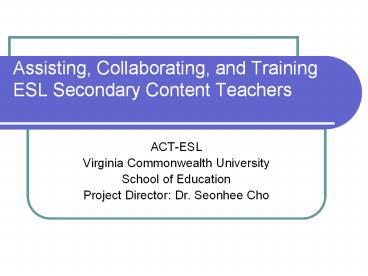Assisting, Collaborating, and Training ESL Secondary Content Teachers - PowerPoint PPT Presentation
1 / 11
Title:
Assisting, Collaborating, and Training ESL Secondary Content Teachers
Description:
Assisting, Collaborating, and Training ESL Secondary Content Teachers ACT-ESL Virginia Commonwealth University School of Education Project Director: Dr. Seonhee Cho – PowerPoint PPT presentation
Number of Views:134
Avg rating:3.0/5.0
Title: Assisting, Collaborating, and Training ESL Secondary Content Teachers
1
Assisting, Collaborating, and Training ESL
Secondary Content Teachers
- ACT-ESL
- Virginia Commonwealth University
- School of Education
- Project Director Dr. Seonhee Cho
2
General Grant Information
- Funding Source U.S. Department of Education
(OELA Office of English Language Acquisition) - Grant Type National Professional Development
- Grant Project Year 5 years (2007-2012)
- Grant Money 1.2 Million
- Partner LEA Chesterfield County Public Schools
3
Chesterfield County Public Schools
- Fast growing ELL population (600 increase in the
past 10 yrs.) - 6 secondary ESL-centered schools and will open 2
more schools next year - 80-90 of ELLs have Hispanic and
socio-economically disadvantaged backgrounds. - SOL passing rate is 20 lower on average (ELL vs.
All)
4
ACT-ESL Major Activities
5
Why do Secondary Content-area Teachers Need
Training?
- Basic Interpersonal Skills (BICs 6 mons.-2 yrs.)
vs. Cognitive Academic Language Proficiency
(CALP 4-8 yrs.) (Collier, 1989Cummins, 1980) - All ELLs after their first year in U.S. school
system are mandated to take high-stakes tests
with the same expectation of academic standards. - High school diploma awarded only to students who
pass SOL tests. - Simultaneous approach to academic content and
language - Depth and breadth of content knowledge, and
discipline-specific and cognitively-demanding
academic language (Chamot OMalley, 1994) - Placements of ELLs in a low academic and
non-college bound track - Content-area teachers area lack of experience
and training to work with ESL students Rare
collaboration beyond teachers disciplinary and
less participation in interdisciplinary training
(Harklau, 1999) - v The role of content-area teachers is critical
in ELLs academic achievements. Thus, ACT-ESL
provides summer training to secondary
content-area teachers using ESL instructional
strategies.
6
1. Goal, Objectives, Activities
- Goal 1 To conduct an ESL instruction summer
intensive training for in-service content-area
teachers. - Performance Objectives 1 In each of the first
four years, approximately 52 in-service teachers
in Math, Science, English/Language Arts, and
Social Studies/History will be trained to use ESL
instructional strategies. - Activities 1 Recruitment of project staff
recruitment of in-service teachers who will work
with ESL students in the following years
development of summer institute curriculum
modules and instructional course content
developing pre-and post-surveys to measure
trainees newly acquired knowledge and skills
development of course evaluation survey
development of rubrics to assess resource books.
7
Why does Teacher Training Need Follow-ups?
- One-shot lectures or demonstrations unrelated to
teachers experiences, prior knowledge, interests
and concerns are inefficient. - ?Integrate teachers concerns and experiences by
actively engaging them in their learning process. - Intended change in a real classroom will not
occur without appropriate follow-ups (Gordon,
2004 Lieberman Miller, 1999). - ? Provide follow-ups and assistance of
implementation until teachers try out new skills
and integrate them into their practice. - v ACT-ESL training adopts a long term in-service
training model and views teachers as a resource
and their current teaching practices as a point
of departure for advancement, enhancement and
changes.
8
2. Goal, Objectives, Activities
- Goal 2 To conduct year long follow-ups with
technical assistance. - Performance objectives 2 Starting from the
second (fiscal) year, all trainees who completed
summer training will receive one-on-one technical
coaching 3 times (twice in fall and once in
spring) and a post-seminar at the end of year. - Activities 2 Recruitment of technical
assistants training technical assistants
technical coaching (classroom observations and
feedback) planning and hosting a post-seminar.
9
Why Should Professional Learning Communities
Develop?
- Externally imposed short-term change program is
not effective in a long run, damaging teachers
long-term commitment to their work (Hargreaves,
2003). - ? Developing professional learning communities is
the most effective way to engage teachers in
change and change of school culture (Gordon,
2004). - ? Secondary content teachers compartmentalization
and disciplinary boundary can help create
professional learning communities within the same
disciplinary group. - v The concept of building professional learning
communities resonates with the ultimate purpose
of the grant, which is building capacity and
yielding results that will last beyond the period
of federal financial assistance.
10
3. Goal, Objectives, Activities
- Goal 3 To develop professional learning
communities related to ESL instruction. - Performance Objectives 3 Starting the end of
year 2, an annual teaching demonstration fair,
and conference presentations and workshops
conducted by trainees will be supported. In
addition, self-directed and assisted action
research and study groups will be facilitated
through financial support and research
assistance. - Activities 3 Annual teaching demonstration fair
conference and workshop presentations action
research paper study groups.
11
Projected Benchmarks of ACT-ESL
Major Target Performance Objectives related to goals Yr. 1 Yr. 2 Yr. 3 Yr. 4 Yr. 5 Total
Summer Institute Participants (n 52 per year ) 52 52 52 52 N/A 208
Technical Assistant Training (n4 per year) 4 4 4 4 N/A 16
Classroom Observations (n 52 X 3 times156) N/A 156 156 156 156 624
Post-Seminar Participants (n52) N/A 52 52 52 52 208
Demonstrators at Teaching Demonstration Fair N/A 12 12 16 16 56
Conference Presentations/Demonstration N/A N/A 8 12 16 36
Study Group/Action Research N/A N/A 8 12 16 36































